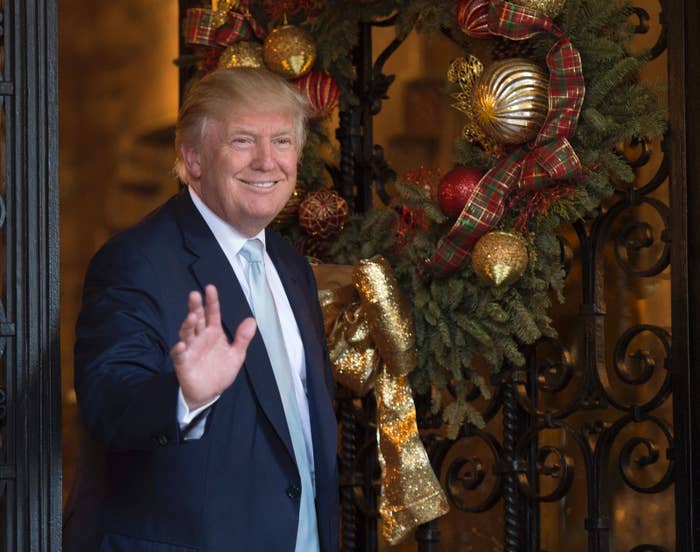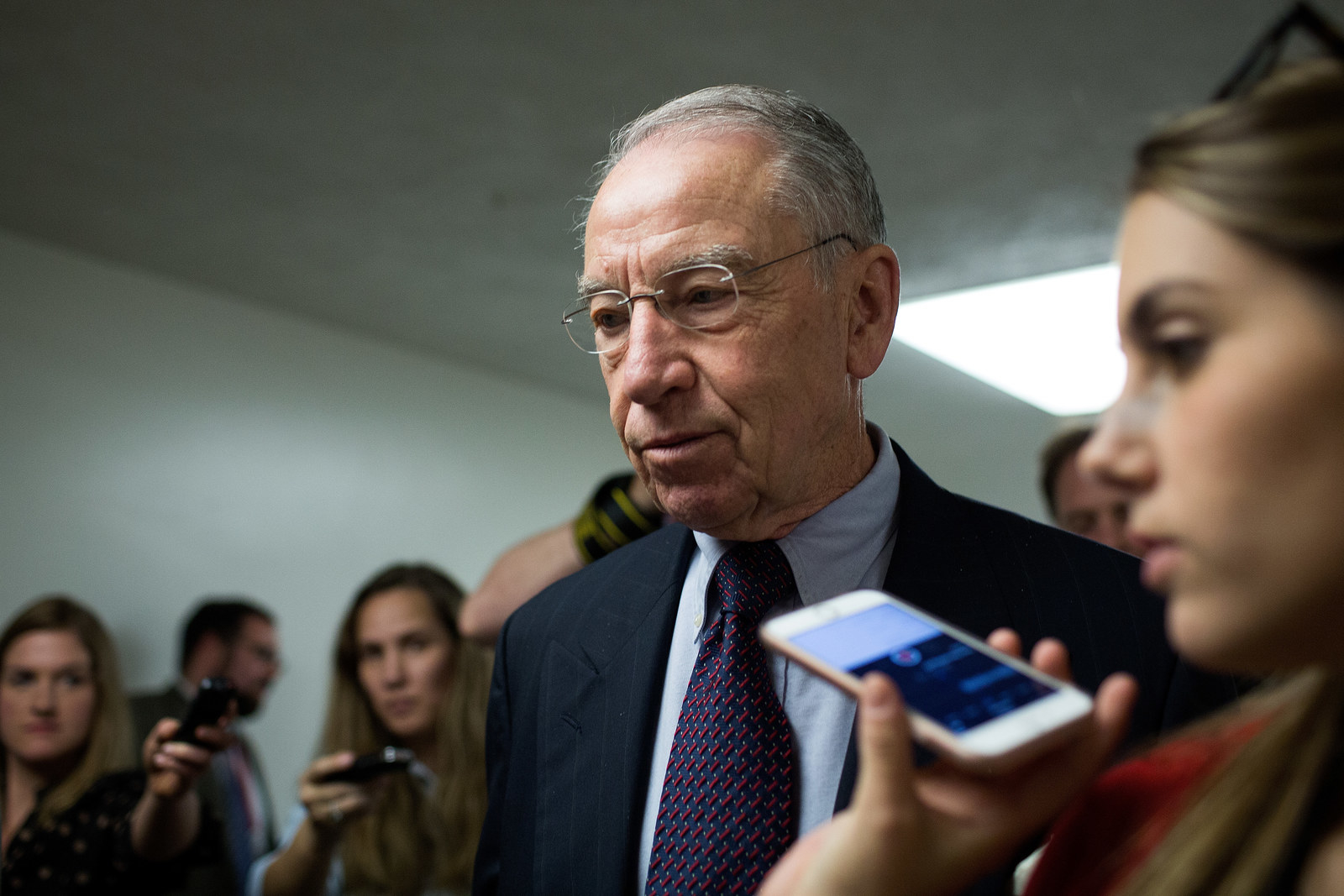
President-elect Donald Trump is poised to influence immigration enforcement, environmental regulation, and civil rights from his first day in office, and he won’t need to propose legislation or sign executive orders to do it.
By the time Trump is sworn in on Jan. 20, there will be more than 100 vacant judgeships across the federal courts. Trump can begin to name nominees for those seats once he takes office — the number of vacancies equals about 12 percent of all active federal judgeships, far more than Presidents George W. Bush or Obama had to fill at the start of their presidencies.
It’s an immediate opportunity for Trump to leave a legacy that would last for decades, and one that Republicans don’t want him to squander.
“A very large number of those circuit courts of appeals flipped during the Obama years, and certainly from the conservatives’ perspective it would be nice to flip some or all of those back,” said John Malcolm, director of the Edwin Meese III Center for Legal and Judicial Studies at the conservative Heritage Foundation. “That’s going to take time. President Obama had eight years.”
The US Supreme Court gets the most attention, with justices who can set new precedent that immediately affects the whole nation — but the vast majority of cases never make it that far. Lower federal courts are where most cases are resolved. Democrats criticized Obama for not acting fast enough naming nominees to US district and appeals courts during his first term, setting the stage for Republicans to block dozens of nominees in his final years in office. It’s a scenario Republicans want to avoid.
Trump’s priority is getting a nominee confirmed to replace Justice Antonin Scalia, who died in February, on the Supreme Court, and that’s expected to dominate the White House and Senate’s judicial agenda early on. Still, Malcolm said the Heritage Foundation and other conservative groups are already tapping their networks to identify potential lower court nominees to suggest to the new administration.
There are open seats for Trump to fill on eight of the thirteen courts of appeals. These courts set precedent in the absence of a Supreme Court decision on a particular issue, and interpret and apply Supreme Court rulings with important practical effects.
"Coming out of this election where the courts were so high on everyone’s radar, I hope this administration is going to take it very seriously."
Senate Republicans succeeded in blocking Obama’s nominees to three of the four appeals courts that still have a majority of Republican-appointed active judges — the US Courts of Appeals for the Fifth, Sixth, Seventh, and Eighth Circuits, which cover a broad swath of the middle of the country, from the mouth of the Mississippi River up through the Midwest. Trump can grow the conservative blocs on those courts, which all have vacancies, right away.
Trump can also narrow the gap between Republican and Democrat-appointed active judges on two appeals courts with several vacancies: the Second Circuit, which covers New York, Connecticut, and Vermont and handles high-profile cases involving the financial industry; and the Third Circuit, which covers Pennsylvania, New Jersey, Delaware, and the Virgin Islands.
To Republicans’ dismay, there are no vacancies for Trump to fill right away on the DC Circuit, a politically significant court that hears challenges to executive branch actions. Obama and Senate Democrats successfully fought to put four relatively young judges on that bench, and Democrat-appointed active judges hold a solid majority.
Federal judges, protective of their independence, bristle at the notion that the politics of the president who appointed them determines how they’ll rule. Lawyers agree that in most cases, a judge’s political background isn’t a factor.
But if Trump picks nominees whose judicial philosophy aligns with the conservative Scalia’s — Trump’s rubric for his Supreme Court nominee — courts could start to shift to the right on issues where Republican and Democratic appointees historically have split: the scope of government regulation, labor, voting rights, and the power of police and prosecutors, for instance.
“Coming out of this election where the courts were so high on everyone’s radar, I hope this administration is going to take it very seriously,” said Carrie Severino, chief counsel and policy director of the conservative Judicial Crisis Network.
The wild-card factor
Trump’s transition team hasn’t announced who will be in charge of judicial nominations. Transition officials did not return a request for comment. Lawyers familiar with previous presidential changeovers said that Trump’s intended White House counsel, Don McGahn II, is likely brainstorming options for the lower courts, especially the courts of appeals, even as the administration gets ready to announce a Supreme Court nominee.
"I’m curious whether ... it’s going to be something radically different."
Sen. Jeff Sessions, Trump’s intended US attorney general nominee, as well as the Heritage Foundation and Federalist Society, are expected to play an influential role on judicial nominations. Heritage and the Federalist Society helped shape Trump’s list of 21 Supreme Court candidates, and Federalist Society executive vice president Leonard Leo met with Trump shortly after the election to discuss the Supreme Court.
Severino, of the Judicial Crisis Network, said her group is prepared to mobilize to support Trump’s judicial nominees. JCN released ads this year opposing Obama’s Supreme Court nominee, DC Circuit Chief Judge Merrick Garland, and recently launched a six-figure digital ad campaign supporting Sessions. Severino declined to comment on whether she’d been in communication with Trump’s transition team.
Presidents of both parties historically have tapped certain pipelines for federal judgeships — former prosecutors, partners at large law firms, and, for appeals court seats, judges already serving on state and federal trial courts. For the US district courts, the White House has largely deferred to the preferences of home state senators.
Trump, however, pledged to upend traditional systems in Washington. It’s not clear yet whether that “drain the swamp” cry will extend to the usual processes in picking court nominees.
“I’m curious whether we’re going to see the types of judges with the types of qualifications and backgrounds that we have seen in the past from presidents of both parties, or whether it’s going to be something radically different,” said Scott Chesin, a partner at the law firm Mayer Brown in New York.
Cases against the government
Judicial nominees for trial-level courts tend to be less politically controversial, but there are open seats that could prove important for Trump as he pursues his agenda.
There are six open seats on the US Court of Federal Claims. Unlike the US district and circuit courts, where judges have lifetime appointments, Federal Claims judges serve 15-year terms. Known as the “People’s Court,” the Court of Federal Claims hears fights against the government over federal contracts, seizures of private property, and tax appeals. Hundreds of millions of dollars can be at stake in these cases.
Republicans blocked Obama’s five nominees to that court. Sen. Tom Cotton — who previously worked at a law firm, Cooper & Kirk, that represents companies in the Court of Federal Claims — questioned whether the court needed more judges given its caseload, and why more cases weren’t being assigned to senior judges.
Democrats accused Republicans of opposing Obama’s nominees to preserve a conservative majority on the bench. Republican appointees are considered more sympathetic to private industry in cases against the government.
Asked if Cotton would continue to oppose filling the vacancies, a spokesperson for the senator told BuzzFeed News in an email that he “will continue to evaluate the caseload of the Court of Federal Claims and ensure that taxpayer dollars are used prudently.”
Lewis Wiener, a partner at the law firm Sutherland Asbill & Brennan in Washington and a former president of the Court of Federal Claims Bar Association, disagrees with Cotton’s assessment of the court’s caseload and the need for more judges. The vacancies are “acutely” felt and are slowing down cases, he said.
“When the legislative branch is doing what it is doing and has been doing, to interfere with the administration of the judiciary, you really risk that balance of power which is a bedrock principle of our constitution,” Wiener said.
Should Trump go forward with filling the vacancies, Hamish Hume, a partner at the law firm Boies, Schiller & Flexner in Washington who practices in the Court of Federal Claims, said he didn’t expect Trump to renominate Obama’s nominees.
“It’s regrettable how politicized our judiciary has become. At some level that’s going to become very hard to undo. The most important thing in light of that politicization is to not let it detract from the fact that we want highly qualified people with a diversity of backgrounds,” Hume said.
Trump also will inherit vacancies for three seats on the US District Court for the District of Columbia, a major forum for lawsuits over federal agency actions and public records requests. Appeals from that court go to the DC Circuit.
There are 11 vacancies across the district courts in Texas, which have heavy immigration dockets and have handled challenges to Obama's executive actions on immigration and other federal regulations and policies. In addition, there are three seats on the Eastern District of New York, known for handling a variety of terrorism and white collar crime cases.

An uphill fight for Democrats
Democrats and liberal advocacy groups are mobilizing to fight Trump’s nominees, but with Republicans in control of the Senate, Democrats will have limited opportunities to block them — particularly the lower court judges — from being confirmed.
Under changes to Senate rules put in place in 2013 when Democrats were in control, it only takes a simple majority in the Senate to defeat a filibuster and move a nominee for the district and appeals courts forward. A 60-vote majority is still required to break a filibuster on a Supreme Court nominee, although there is speculation Republicans would change that to a simple majority vote as well if Democrats try to block Trump’s Supreme Court nominee.
Under a system known as the “blue slip” process, the Senate Judiciary Committee won’t act on a nominee unless the home state senators return a piece of paper with their approval. The blue slip process has long served as a negotiating tool for senators in opposition to the president, and Senate Judiciary Committee Chairman Chuck Grassley will continue to honor it, according to a spokesperson.
Civil rights and liberal advocacy groups say they’ll launch public advocacy campaigns to oppose nominees they object to, but the left hasn’t been as centrally organized as conservatives when it comes to the courts, said Robert Raben of lobbying and policy firm The Raben Group, a former lawyer at the Justice Department and on Capitol Hill who works as a strategist with liberal groups. There is no left-wing equivalent of the Judicial Crisis Network, he said.
Looking at Trump’s list of Supreme Court candidates, Democrats have an idea of the types of judges the president-elect could choose for the lower courts and are doing research on potential nominees, Raben said. They’re also waiting to see who Trump picks to take the lead on judicial nominations, he said.
“We really have an interesting infrastructure mismatch on the left and right,” Raben said. “That said, we are of course organizing.”
